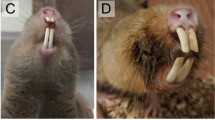Abstract
Whole-body volatiles from males of the cryptic multimammate mouse speciesMastomys natalensis andM. coucha were analyzed by dynamic solvent effect sampling and capillary gas chromatography. One compound, 3-nonene-2-one, was always present, sometimes as the major component, in volatiles fromM. coucha and absent, or present only at low levels, in volatiles fromM. natalensis. The mean ±SD of the 3-nonen-2-one peak area forM. coucha was 8599 ±9630 and forM. natalensis 148 ±486. Chromatographic analysis was more reliable in identifying a male's species than were a female's in a two-choice olfactorium.
Similar content being viewed by others
References
Apps, P.J. 1988. The quantitative analysis of semiochemicals. PhD thesis. University of Pretoria.
Apps, P.J., Pretorius, V., Lawson, K.H., Rohwer, E.R., Centner, M.R., Viljoen, H.W., andHülse, G. 1987. Trace analysis of complex organic mixtures using capillary gas-liquid chromatography and the dynamic solvent effect.J. High Resol. Chromatogr. Chromatogr. Commun. 10:122–127.
Apps, P.J., Rasa, A., andViljoen, H.W. 1988. Quantitative Chromatographic profiling of odours associated with dominance in male laboratory mice.Agress. Behav.14:451–461.
Bartke, A., andDalterio, S. 1975. Evidence for episodic secretion of testosterone in laboratory mice.Steroids 26:749–756.
Beauchamp, G.K., Criss, B.R., andWellington, J.L. 1979. Chemical communication inCavia: Responses of wild (C.Apera), domestic (C.Porcellus) and F1 males to urine.Anim. Behav. 27:1066–1072.
Bowers, J.M., andAlexander, B.K. 1967. Mice: Individual recognition by olfactory cues.Science 158:1208–1210.
Bronner, G., Rautenbach, I.L., andMeester, J. 1988. Environmental influence on reproduction in the Natal multimammate mouseMastomys natalensis (A. Smith).S. Afr. J. Wildl. Res. 18(4): 142–148.
Carter, R.L., andBrand, L.R. 1986. Species recognition in wild-caught, laboratory-reared and cross-fosteredPeromyscus californicus andPeromyscus eremicus (Rodentia, Cricetidae).Anim. Behav. 34:998–1006.
Cox, T.P. 1984. Ethological isolation between local populations of house mice (Mus musculus based on olfaction.Anim. Behav. 32:1068–1077.
Dagg, A.I., andWindsor, D.E. 1971. Olfactory discrimination limits in gerbils.Can. J. Zool. 49:283–285.
De Jonge, G. 1980. Responses to con- and hetero-specific male odours by the volesMicrotus agrestis, M. arvalis andClethrionomys glareolus with respect to competition for space.Behaviour 73:277–302.
Doty, R.L. 1972. Odor preferences of femalePeromyscus maniculatus bairdii for male mouse odours ofP. m. bairdii andP. leucopus noveboracensis as a function of oestrous state.J. Comp. Physiol. Psychol. 81:191–197.
Doty, R.L. 1973. Reactions of deermice (Peromyscus maniculatus) and white footed mice (Peromyscus leucopus) to homospecific and heterospecific urine odours.J. Comp. Physiol. Psychol. 84:296–303.
Drickamer, L.C. 1984. Captures of two species ofPeromyscus at live traps baited with male and female odors.J. Mammal. 65:699–702.
Drickamer, L.C., andLenington, 1987. T-locus effects on the male urinary chemosignal that accelerates puberty in female mice.Anim. Behav. 35:1581–1582.
Godfrey, J. 1958. The origin of sexual isolation between bank voles.Proc. R. Soc. Edinburgh 27:47–55.
Gordon, D.H. 1978. Distribution of sibling species of thePraomys (Mastomys) natalensis group in Rhodesia (Mammalia: Rodentia).J. Zool. London 186:397–401.
Gordon, D.H. 1984. Evolutionary genetics of thePraomys (Mastomys) natalensis species complex (Rodentia: Muridae). PhD thesis. University of the Witwatersrand.
Gordon, D.H., andWatson, C.R.B. 1986. Identification of cryptic species of rodents (Mastomys, Aetkomys, Saccostomus) in the Kruger National Park.S. Afr. J. Zool. 21:95–99.
Green, C.A., Gordon, D.H., andLyons, N.F. 1978. Biological species inPraomys (Mastomys) natalensis (Smith), a rodent carrier of Lassa virus and bubonic plague in Africa.Am. J. Trop. Med. Hyg. 27:627–629.
Green, C.A., Keogh, H., Gordon, D.H., Pinto, M., andHartwig, E.K. 1980. The distribution, identification and naming of theMastomys natalensis species complex in southern Africa (Rodentia: Muridae).J. Zool. London 192:17–23.
Jemiolo, B. Andreolini, F. Wiesler, D., andNovotny, M. 1987. Variations in mouse (Mus musculus) urinary volatiles during different periods of pregnancy and lactation.J. Chem. Ecol. 13:1941–1956.
Keogh, H., andPrice, P.J. 1981. The multimammate mice: A review.S. Afr. J. Sci. 77:484–488.
Lenington, S. 1983. Social preferences for partners carrying “good genes” in wild house mice.Anim. Behav. 31:325–333.
Liebich, H.M., Zlatkis, A., Bertsch, W., Van Dahm, R., andWhitten, W.K. 1977. Identification of dihydrothiazoles in urine of male mice.Biomed. Mass Spectrom. 4:69–72.
Lyons, N.F., Green, C.A., Gordon, D.H., andWalters, C.R. 1977. G-banding chromosome analysis ofPraomys natalensis (Smith) (Rodentia: Muridae) from Rhodesia 1. 36 chromosome population.Heredity 38:197–200.
Lyons, N.F., Gordon, D.H., andGreen, C.A. 1980. G-banding chromosome analysis of species A of theMastomys natalensis complex (Smith, 1834) (Rodentia: Muridae).Genetica 54:209–212.
Moore, E. 1965. Olfactory discrimination as an isolating mechanism betweenPeromyscus maniculatus andPeromyscus polionotus.Am. Midl. Nat. 73:85–100.
Nevo, E., Bodmer, M., andHeth, G. 1976. Olfactory discrimination as an isolating mechanism in speciating mole rats.Experientia 32:1511–1512.
Novotny, M., Jemiolo, B., Harvey, S., Wiesler, D., andMarchlewska-Koj, 1986. Adrenalmediated endogenous metabolites inhibit puberty in female mice.Science 231:722–725.
Schwende, F.J., Jorgenson, J.W., andNovotny, M. 1984. Possible chemical basis for histocompatibility related mating preference in mice.J. Chem. Ecol. 10:1603–1615.
Selander, R.K.,Smith, M.H.,Yang, S.Y.,Johnson, W.E., andGentry, J.B. 1971. Biochemical polymorphism and systematics in the genusPeromyscus, I. Variation in the old-field mouse (Peromyscus polionotus). Studies in Genetics VI. Univesity of Texas Publications, Austin, Texas. 7103, pp. 49–90.
Smithers, R.H.N. 1983. The Mammals of the Southern African Subregion. University of Pretoria, Pretoria.
Stoddart, D.M. 1977. Two hypotheses supporting the social function of odourous secretions in some old world rodents, pp. 333–356,in D. Muller-Schwarze and M.M. Mozell (eds.). Chemical Signals in Vertebrates. Plenum Press, New York.
Stoddart, D.M., andSmith, P.A. 1984. Woodmice (Apodemus sylvaticus) can distinguish conspecific from heterospecific odors in the field.J. Chem. Ecol. 10:923–928.
Yamazaki, K., Yamaguchi, M., Boyse, E.A., andThomas, L. 1980. The major histocompatibility complex as a source of odors imparting individuality among mice, pp. 267–273,in D. Muller-Schwarze and R.M. Silverstein (eds.). Chemical Signals Vertebrates and Aquatic Invertebrates. Plenum Press, New York.
Author information
Authors and Affiliations
Rights and permissions
About this article
Cite this article
Apps, P.J., Gordon, D.H., Viljoen, H.W. et al. Chromatographic analysis of species specific odor profiles inMastomys natalensis andM. coucha (Rodentia: Muridae). J Chem Ecol 16, 2667–2676 (1990). https://doi.org/10.1007/BF00988077
Received:
Accepted:
Issue Date:
DOI: https://doi.org/10.1007/BF00988077




